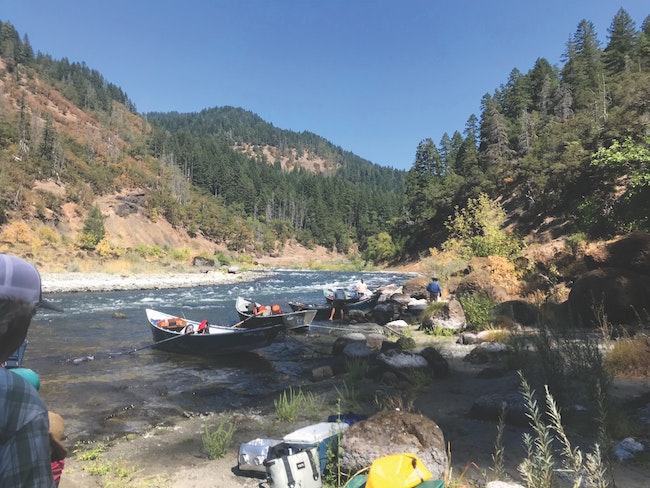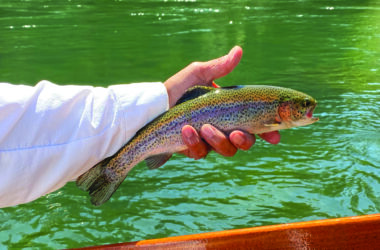 Lunching at the base of Clay Hills Rapid. There is a lot of good steelhead water in this section of the river and the largest of the rapids are now behind us;ses. FRANK ARMENDARIZ/CHRONICLE PHOTOS
Lunching at the base of Clay Hills Rapid. There is a lot of good steelhead water in this section of the river and the largest of the rapids are now behind us;ses. FRANK ARMENDARIZ/CHRONICLE PHOTOS
As you float away from Grave Creek landing, before you even have time to wave goodbye … Oregon’s Wild and Scenic Rogue River immediately gets your attention.
A strong current grabs you, forcing you to maneuver your river boat on a rush of whitewater that pours around the boulders in the upper rapid. You pull hard on the oars, looking down river for the perfect line that will carry your craft over the lip and safely through “Lower Grave Creek Falls.” A six-foot vertical drop, the very first Rogue River canyon rapid, fully deserving of its class three rating and only a sample of what lays ahead.
A short distance down river you hear a waterfall, the sound growing louder as you drift forward. Stopping to scout above where the river disappears and cascades over a cliff, the totality of one of North America’s most famous “big drops” — Rainie Falls comes into view. The falls are breathtaking and our party pauses for a bit to watch while dozens of steelhead and salmon leap the fall and pass upstream. But only a short break before the arduous task of rope lining our drift boats down a small, steep channel on “river right.” Allowing us to forego the worst of the falls, it’s no small feat and our crew is relieved to have the chore behind them. But on the Rogue there is no letting down.
Though we came specifically for the fishing, a float through the river canyon is always first, a technical class 3-4 whitewater experience. Tyee Rapid is a class four, Wildcat Rapid, Slim Pickens, upper and lower Black Bar Falls are solid class threes. That is not to forget a dozen other rapids rated at class two and two-plus that also lay ahead on just the first river day. The rapids are all challenging but all our boatmen successfully negotiate the whitewater and we reach the historic Black Bar Lodge late that afternoon. Black Bar is one of several historic wilderness lodges that were grandfathered into the wild and scenic act (and still remain in operation) when the river was granted the designation.
 Oregon’s Rogue River was designated as one of America’s first eight “Wild and Scenic Rivers” in 1968. Prominent in Oregon’s history, it flows through one of the country’s most pristine wildernesses.
Oregon’s Rogue River was designated as one of America’s first eight “Wild and Scenic Rivers” in 1968. Prominent in Oregon’s history, it flows through one of the country’s most pristine wildernesses.
Let me add, the quality of a Rogue River float is by design. The Rogue because of its extraordinary environment was originally protected by Congress back in 1968. “The American Wild and Scenic Rivers Act” was signed by President Johnson that same year and upon the signing of the landmark legislation the Rogue was included among the first of eight rivers ever granted the statu. … In Public Law 90-542 are these words…
“It is hereby declared to be the policy of the United States that certain selected rivers of the Nation which, with their immediate environments, possess outstandingly remarkable scenic, recreational, geologic, fish and wildlife, historic, cultural or other similar values, shall be preserved in free-flowing condition, and that they and their immediate environments shall be protected for the benefit and enjoyment of present and future generations.”
The protections provided for under the Wild and Scenic River Act now cover 226 other rivers across the country. I first floated the Rogue River in 1982, plus several times since then and again last week. I can tell you that more than fifty years after the passage of the legislation, those extraordinary qualities still exist and it is a magnificent wilderness with plenty of wildlife.
Nested between the rapids the Rogue reveals its “fishing water.” The grail of fabled storied that have enchanted anglers from all over the world for more than a hundred years. Stories of wilderness adventures, catching giant salmon and steelhead and we were there to fish the Rogue’s famous fall run of “half-pounders.” A half-pounder is an immature steelhead that only lives a few months in the ocean. Possibly an evolved survival strategy, thousands of these immature steelhead return to the Rogue each fall.
A mixture of wild and hatchery fish and sexually immature, the fish don’t spawn or die in the river like most adult steelhead. But rather just “overwinter” in the comfort of the Rogue’s abundant aquatic life. Then they drift back to the ocean in late winter, returning to the river the following year as adult steelhead. Have no doubt, even though they are smaller than their two salt kin, these are “steelhead.” Acrobatic, hard fighting and can grow to over two pounds in their short ocean visit. A schooling fish, so where you find one, there are likely dozens more and only a few rivers in the world have them.
On our second river day, the Rogue lays down a bit. There are still rapids to navigate but they are less numerous and there are more opportunities to fish. Several half-pounders were caught on our first river day, the second day’s action got that much better. On the “twitched” wet flies that we were swinging in the current, ahead of our drift boats. We overnighted at the Marial Lodge which is situated high on the river bank at the entrance to Mule Creek Canyon and was once a post office.
 A Rogue River half-pounders steelhead, this one about a pound-and-a-half. Caught with the traditional “Rogue River wet fly twitch,” a 100-year-old technique that endures today because of its effectiveness.
A Rogue River half-pounders steelhead, this one about a pound-and-a-half. Caught with the traditional “Rogue River wet fly twitch,” a 100-year-old technique that endures today because of its effectiveness.
When we leave Marial we are again “quick to the oars.” The “Jaws” that guard the entrance to Mule Creek Canyon and its notorious “Coffee Pot” come quickly into view. Then soon after, we confront the most challenging rapid on the Rogue River, “Blossom Bar.” A technical collection of boulders, where the river seems to disappear under car-sized rocks. Running Blossom in any style of river boat leaves no margins for error. Fortunately on this day no errors were made and our five McKenzie-style drift boats float through Blossom with no drama.
Every day we traveled down river there were more riffles to fish and the fishing got better and markedly better below Blossom Bar. Where our third day was likely the best and yielded enough hatchery half-pounders by late morning for a robust riverside lunch of fried steelhead for our party of fifteen anglers. After lunch, as we floated toward our final night’s destination, the steelhead holding water was even more abundant and a dozen or more half-pounders were caught and released by our group of anglers before reaching the lodge.
Our final night on the Rogue River was spent at the Illahe Lodge. Where for boating parties its “Thanksgiving” every night. Turkey, stuffing, mashed potatoes, gravy, biscuits … and all the fixings. It was a meal befitting the ending of such a wonderful whitewater and fishing adventure that everyone was thankful to be on. It was a river trip of a lifetime
Email:
Listen:
Frank is on KDUN 1030 AM, streaming at radio.net/s/kdun








